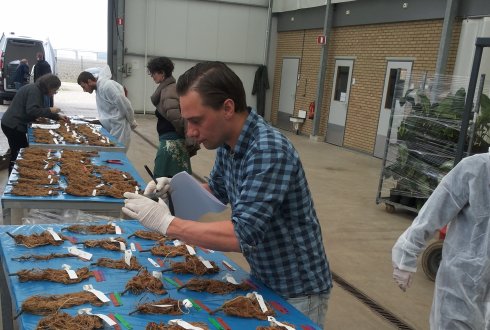Wageningen, the Netherlands
August 31, 2015

The root knot nematode (Meloidogyne incognita) represents a threat in the cultivation of tomato in organic greenhouse horticulture. Together with growers, the Farming Systems Ecology group of Wageningen University and WUR Greenhouse Horticulture a trial was started to investigate diverse means of control.
For the trial, 5 L pots were used and filled with soil that originated from a grower. The investigation included diverse types of compost, additives such as silicon and diverse antagonists of the root knot nematode. The means of control were tested separately and combined to study a synergistic action. Especially a woody type of compost and champost with silicon were effective and reduced the number of root knots on the root system of tomato cv. Capricia. In addition, woody compost reduced the number of offspring (J2) from the infested roots. An addition of the fungus Trichoderma sp. was counter effective. A combination of champost and silicon was effective as well. The combination showed even a synergistic effect, i.e., it was more effective in reducing the number of root knots when compared to champost and silicon separately. Champost has to be used with care since it may result in a damage of the roots.
Champost tegen wortelknobbelaaltjes in de biologische teelt van vruchtgroenten
Wortelknobbelaaltjes vormen een probleem voor de biologische teelt van vruchtgroenten. Samen met biologische telers, de vakgroep Biologische Bedrijfssystemen aan de Universiteit Wageningen en Wageningen UR Glastuinbouw werd in Bleiswijk is een proef ingezet met tomaat cv. Capricia om maatregelen te toetsen voor de opkweek en teelt.
Hiervoor werden 5 L potten gevuld met grond van een teler. Het onderzoek richtte zich op diverse composten, additieven zoals silicium en antagonisten van wortelknobbelaaltjes. De maatregelen werden afzonderlijk getoetst en in combinatie met elkaar om te zien of er een extra sterk effect kon worden bereikt. Vooral houtachtig compost en champost met silicium bleken het aantal wortelknobbels op de wortels te verminderen. Houtachtig compost resulteerde daarnaast ook in het verminderen van het aantal nakomelingen. Een toevoeging van de schimmel Trichoderma werkte averechts en het onderdrukkend effect werd minder. De combinatie van champost en silicium gaf ook een vermindering van de wortelknobbels. Een combinatie van beide werkte zelfs beter dan elk afzonderlijk. Gebruik van champost gaf ook nog eens een grotere (zwaardere) tomatenplant. Het toedienen van champost moet wel voorzichtig gebeuren omdat het scherp materiaal is en er schade aan wortels kan optreden.
Dit project is gefinancierd door Topsector A&F en mede mogelijk gemaakt door Biologische telers vruchtgroenten: Gebr. Verbeek, De Koning, Greenshield/ Van Schie en in samenwerking met Louis Bolk Instituut en Bionext.